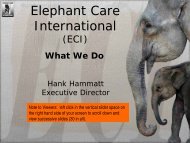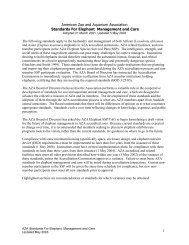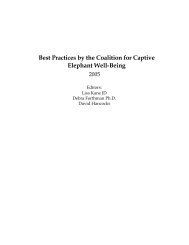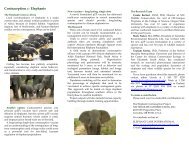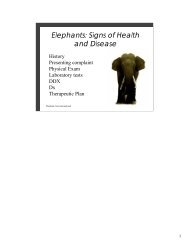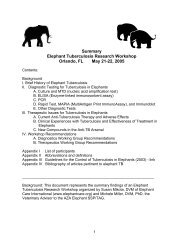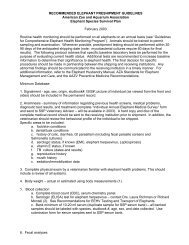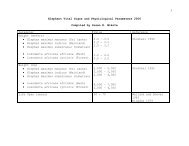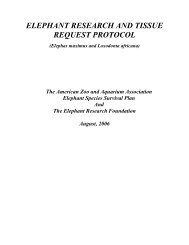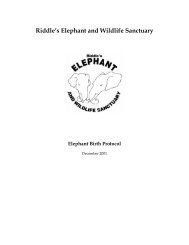Nepal Elephant TB Control and Mgt Action Plan.pdf - Elephant Care ...
Nepal Elephant TB Control and Mgt Action Plan.pdf - Elephant Care ...
Nepal Elephant TB Control and Mgt Action Plan.pdf - Elephant Care ...
- No tags were found...
You also want an ePaper? Increase the reach of your titles
YUMPU automatically turns print PDFs into web optimized ePapers that Google loves.
<strong>Nepal</strong> <strong>Elephant</strong> Tuberculosis <strong>Control</strong> <strong>and</strong>Management <strong>Action</strong> <strong>Plan</strong> (2011-2015)See secon 1.5 for details.• <strong>Elephant</strong>s that have completed treatment willbe designated as Group 3 - Treated.Note: <strong>TB</strong>-suspect <strong>and</strong> <strong>TB</strong>-infected elephantsshould be treated under most situaons. Thedecision to treat old or pregnant animals shouldbe made on a case by case basis. While veryold elephants with long-st<strong>and</strong>ing infecons areunlikely to be cured, treatment may preventshedding <strong>and</strong> older elephants (>50 years) in<strong>Nepal</strong> have undergone treatment with minimal tono side effects.<strong>TB</strong> drugs have also been administered to lactangelephants with no side effects to mother or calf.In one case a pregnant elephant under treatmentaborted but it is unknown whether this wasassociated with the <strong>TB</strong> drugs or other causes.<strong>TB</strong> drugs are rounely administered to pregnanthumans with no ill effects.If a decision is made to withhold treatment ofa <strong>TB</strong>-infected elephant, the elephant should bemaintained in permanent segregaon for theremainder of its life <strong>and</strong> contact with wildlifestrictly prevented. Because of their highly socialnature, visual <strong>and</strong> auditory proximity to otherelephants is acceptable as long as the distanceprecludes any direct contact with respiratorysecreons, the elephant is cared for by aseparate h<strong>and</strong>ler (wearing personal protecon)<strong>and</strong> separate cleaning utensils are used for theinfected elephant. All untreated <strong>TB</strong>-infectedelephants are a risk to other elephants, humans,<strong>and</strong> wildlifeGroup 4. Untested: An elephant that has not yetbeen tested for <strong>TB</strong>. Untested elephants alreadyin <strong>Nepal</strong> (such as calves) should be tested assoon as possible. <strong>Elephant</strong>s entering <strong>Nepal</strong>should be tested prior to entering <strong>Nepal</strong> by alicensed veterinarian experienced in performingthe <strong>Elephant</strong> <strong>TB</strong> Stat-Pak ® test or by the <strong>TB</strong> <strong>Plan</strong>Veterinary Officer.Wri#en documentaon must include theelephant’s name; age; sex; owner’s name<strong>and</strong> contact informaon; veterinarian’s name<strong>and</strong> contact informaon; <strong>and</strong> test result. Aphotograph of the elephant <strong>and</strong> a photographof the test labeled with the elephant’s name <strong>and</strong>date of the test must be included. The <strong>TB</strong> <strong>Plan</strong>Veterinary Officer has the authority to test newelephants or to re-test elephants to verify testresults upon arrival in <strong>Nepal</strong>.7



